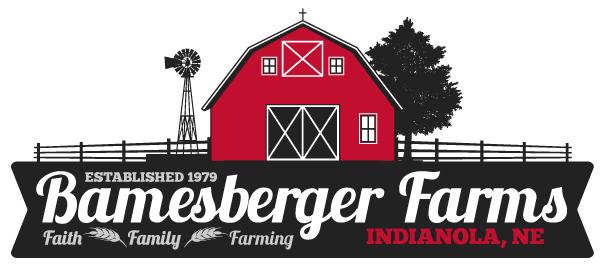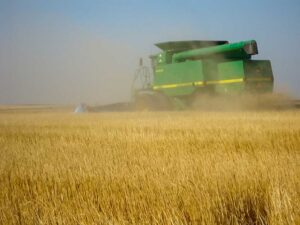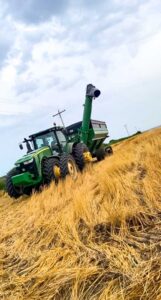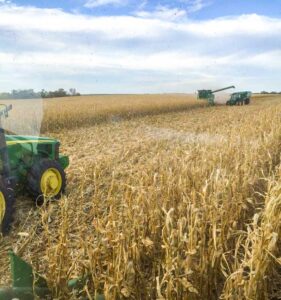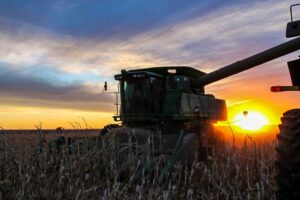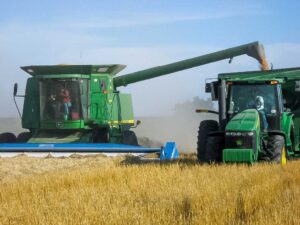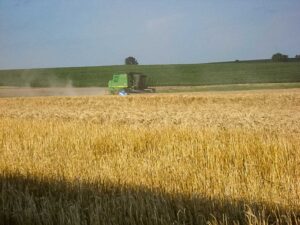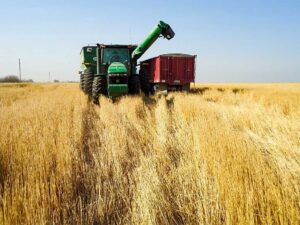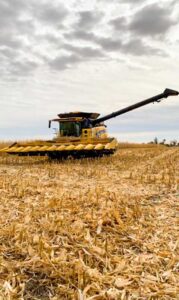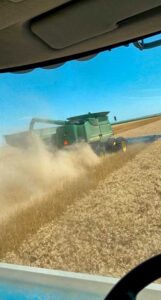Harvest
Reaping the Harvest
Reaping the Harvest; what started months prior, with soil sampling, seed selection, planting, fertilizing, spraying, and praying for rain, climaxing with gathering the crop that we worked so hard to produce.
Operations Corn
We operate two combines and two grain carts in the harvest field when the corn yield is high. Unloading on the go from the combine to the grain cart creates optimum efficiency. Our truck lineup will vary as well, depending on distance to the elevator and the yield of the crop. Three to four semi’s are usually sufficient to keep the combines moving forward when hauling to the bin or elevator. For extra storage we started utilizing grain bags at the edge of the field.
Bags vary in size, but the ones we use hold around 12,000 bushels. It takes a special machine to load the bag, but it saves time and labor as the cart dumps directly into it, eliminating the need for trucks. Using another machine at a later date, we unload the grain from these bags and haul it to the market end point.
Operations Wheat
For wheat we use shelbourne headers to leave as much stubble standing as possible. Stripper header harvested stubble provides more moisture conserving benefits than conventionally harvested stubble. Research has found that the stripped wheat stubble reflects heat, reducing evaporation. It also increases water infiltration, traps snow and, ultimately, increases soil water storage furthering the reduction of evaporation.
With only 20 inches of annual moisture, we have to do everything we can to preserve moisture. The value of one inch of stored water can equal an average of 25 additional dollars per acre, depending on the crop. The result of moisture conservation is usually quite evident the first week of May, when corn planting begins, continuing through the heat of August. Thus making it paramount to keep moisture in the ground under that blanket of straw.
Technology & Data
The grain cart operators monitor and log the scales data loaded out of each field. One of which is on an ipad, which can also be viewed from the combine via bluetooth to the iphone. Each load is recorded on each field and a summary can be emailed back to the office for printing. The second cart we run in fall crops keep a written record which is added to the electronic record after each field is completed. This final summary includes cart scales weight, time loaded, field, gps location, and elevator account number. This helps keep everything straight when checking ticket errors by totaling loads for each field.
Elevator scale tickets and grain cart logs from the prior days harvest is checked, recorded and filed for future reference. At the end of harvest, data from the combines can be downloaded and printed for the file as well which includes yield from every portion of the field. This data is important to the landlords and the insurance agent who keeps a record of average yield history. This yield data also needs to be recorded at the FSA office and crop insurance team.
Insurance
We carry Federal Crop Insurance and report our yields after each harvest to calculate into a running average for each field. The price of insurance depends on the level we choose. We typically use a 70% – 75% level, picking the point of “Best bang for our buck”. In the event of a loss, the insurance price (obtained from a futures average during the month of harvest) will be multiplied by the coverage percent of our proven yield developed from each year. It is very important to maintain good yield averages to optimize insurance returns.
Wheat Harvest 2023
When you think the tough year is behind you, God has a different plan. This year started with challenges with lack of rain in the fall of 22 when we planted. Emergence was spotty and remained so throughout the growing period. Spring rains did come, which helped what was there, but for the most part the stand was established. We did spray fungicide on the better looking fields. Late maturing plants delayed harvest until July 11th, the latest we have ever started. Thus weeds were an issue throught the harvest period.
The price of wheat is very volitile at the expense of global unrest, which offers short windows of opportunity to market at a profit. Our whole farm average of 49 bushels per acre is a reflection of the challenges we faced with short stands, but also severe hail in some areas. As always, it could be worse. It was hard to determine which variety performed the best between Ruth, Monument, Wolverine and Lynk.
Wheat Harvest Highlights
- Whole farm average was 49 bushels per acre.
- Test weights ranged from 52 to 58 pounds per bushel.
- Grain moisture content averaged around 10.5%.
- The highest yield was 61 bushels per acre.
- The lowest yield was 13 bushels per acre (Newly broke out field)
- The stubble left for ecofallow is thin and packed with weeds.
Corn Harvest 2023
This year we began planting with a very low profile of moisture. Planting went well with a much needed rain delay about midway through planting. Emergence was fair with a couple more timely rains the corn was well underway when hail damaged about a third of the crop. Then as the season went along, the August heat and wind took another percentage of yield away. Harvest went quickly with low yields and grain drying down adequately. Our whole farm average was 92 bushels per acre on dryland and 212 on irrigated. Better than last year but still less than what I would consider average. Harvest was completed in late October.
Corn Harvest Highlights
- Test weights ranged from 57 to 59 pounds per bushel.
- Grain moisture content averaged around 13.5%.
- The dryland corn averaged 92 bushels per acre.
- The highest dryland yield was 131 bushels per acre.
- The lowest dryland yield was 47 bushels per acre.
- The irrigated yield was 212 bu/A.
James 3:18
Wisdom from Above
18 And a harvest of righteousness is sown in peace by those who make peace.
